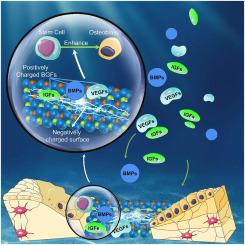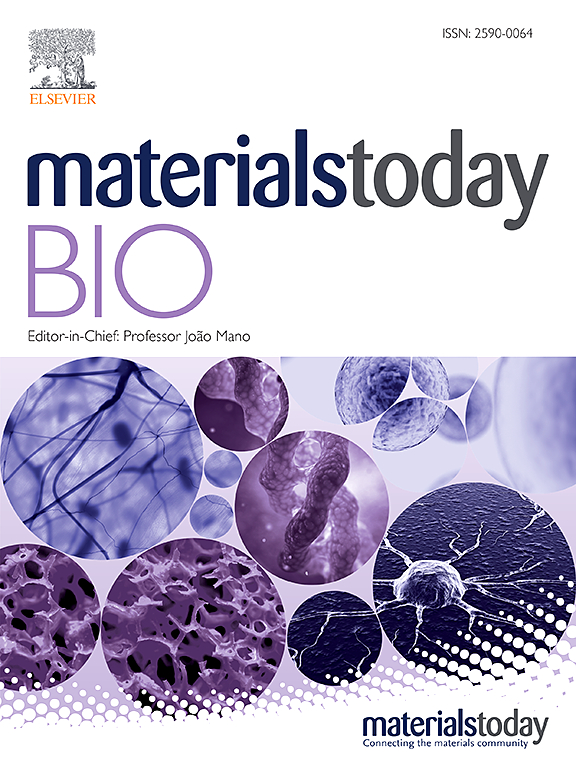通过调整表面化学键状态增强骨诱导性:调动宿主骨生长因子促进原位骨再生的策略
IF 8.7
1区 医学
Q1 ENGINEERING, BIOMEDICAL
引用次数: 0
摘要
将生长因子与生物材料结合是一种很有前景的改善骨结合的策略。然而,目前开发含有外源性生长因子的生物材料的策略存在效率低、难以部署和潜在的脱靶激活等缺点,因此将其应用于临床实践具有挑战性。本研究揭示了一种生物活性 N 掺杂碳化钽(TaC)固溶体薄膜,可用于通过仿生界面工程构建 TaCN 薄膜,将宿主骨生长因子招募到创伤部位并改善骨再生。X 射线光电子能谱(XPS)和蛋白质吸收分析表明,TaCN 的性能与薄膜的表面化学键有关。在 TaCN 中引入 N 会产生级联效应,使 TaCN 表面富集负电荷,并促进带正电荷的骨生长因子在 TaCN 薄膜周围聚集。在这种情况下,内源性骨生长因子可促进骨愈合。TaCN 薄膜在体内成骨分化方面表现突出,体外细胞相容性也很好。在 TaC 中加入 N 原子为调动宿主骨生长因子实现原位骨再生提供了一种新的临床可转化策略,而无需加入外源性生长因子。本文章由计算机程序翻译,如有差异,请以英文原文为准。

Osteoinductivity enhancement by tailoring the surface chemical bond status: A strategy to mobilize host bone growth factors for in situ bone regeneration
The incorporation of growth factors and biomaterials is a promising strategy for improving osseointegration. However, current strategies to develop biomaterials with exogenous growth factors present disadvantages like inefficiency, difficult deployment, and potential off-target activation, making their translation into clinical practice challenging. This study reveals a bioactive N-doped tantalum carbide (TaC) solid solution film that can be used to construct a TaCN film via bionic interface engineering to recruit host bone growth factors to the wounded site and improve bone regeneration. X-ray photoelectron spectroscopy (XPS) and protein absorption analysis reveal that the performance of TaCN is related to the surface chemical bonds of films. The introduction of N to TaC causes a cascade effect wherein negative charges enrich on the TaCN surface, and the recruitment of positively charged bone growth factors around the TaCN film is facilitated. Under these circumstances, the endogenous bone growth factors enhance bone healing. The TaCN film shows an outstanding performance for in vivo osteogenic differentiation along with a superior in vitro cytocompatibility. Incorporation of N atoms into TaC provides a new clinically translatable strategy to mobilize host bone growth factors for in situ bone regeneration without the need for incorporation of exogenous growth factors.
求助全文
通过发布文献求助,成功后即可免费获取论文全文。
去求助
来源期刊

Materials Today Bio
Multiple-
CiteScore
8.30
自引率
4.90%
发文量
303
审稿时长
30 days
期刊介绍:
Materials Today Bio is a multidisciplinary journal that specializes in the intersection between biology and materials science, chemistry, physics, engineering, and medicine. It covers various aspects such as the design and assembly of new structures, their interaction with biological systems, functionalization, bioimaging, therapies, and diagnostics in healthcare. The journal aims to showcase the most significant advancements and discoveries in this field. As part of the Materials Today family, Materials Today Bio provides rigorous peer review, quick decision-making, and high visibility for authors. It is indexed in Scopus, PubMed Central, Emerging Sources, Citation Index (ESCI), and Directory of Open Access Journals (DOAJ).
 求助内容:
求助内容: 应助结果提醒方式:
应助结果提醒方式:


